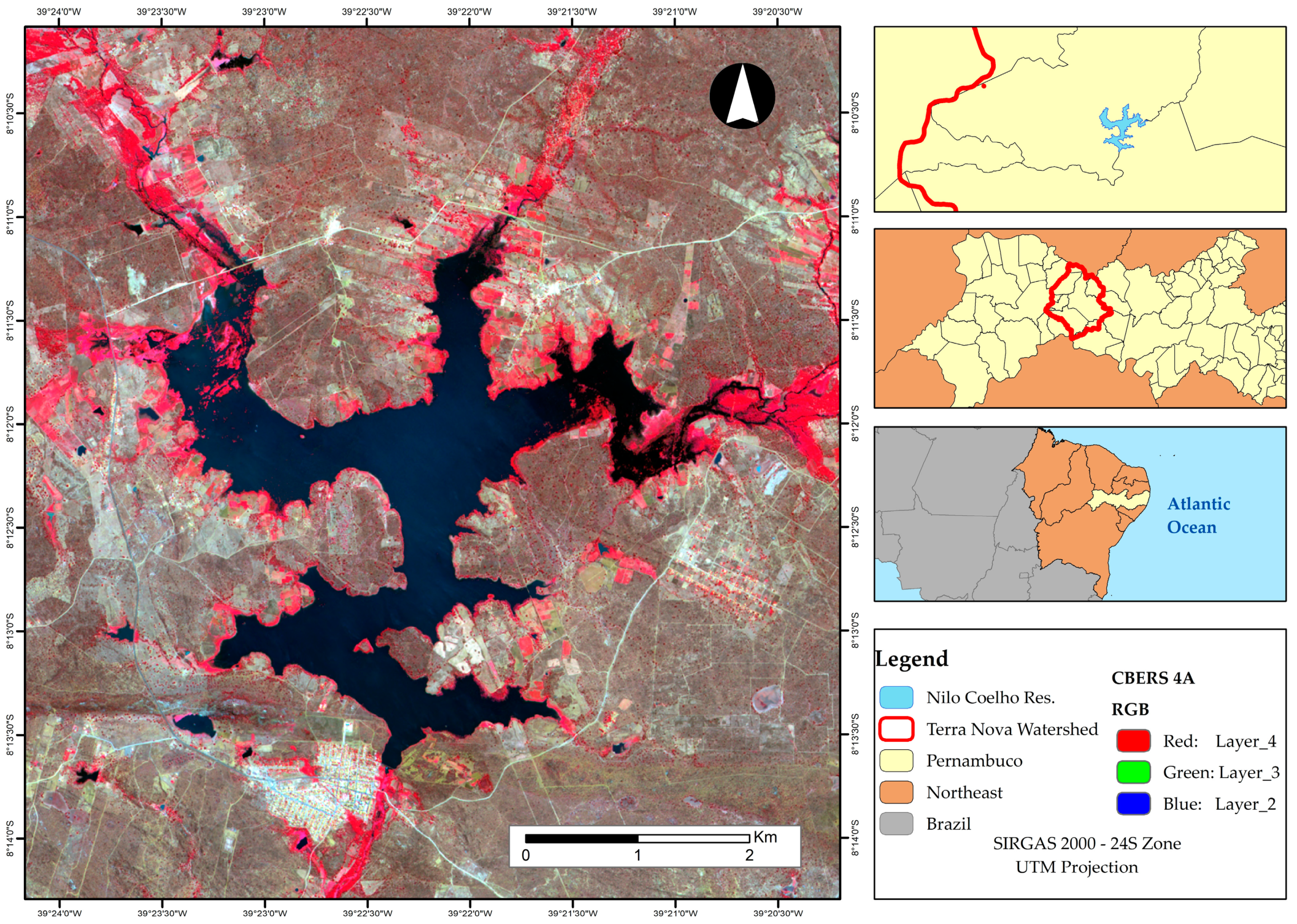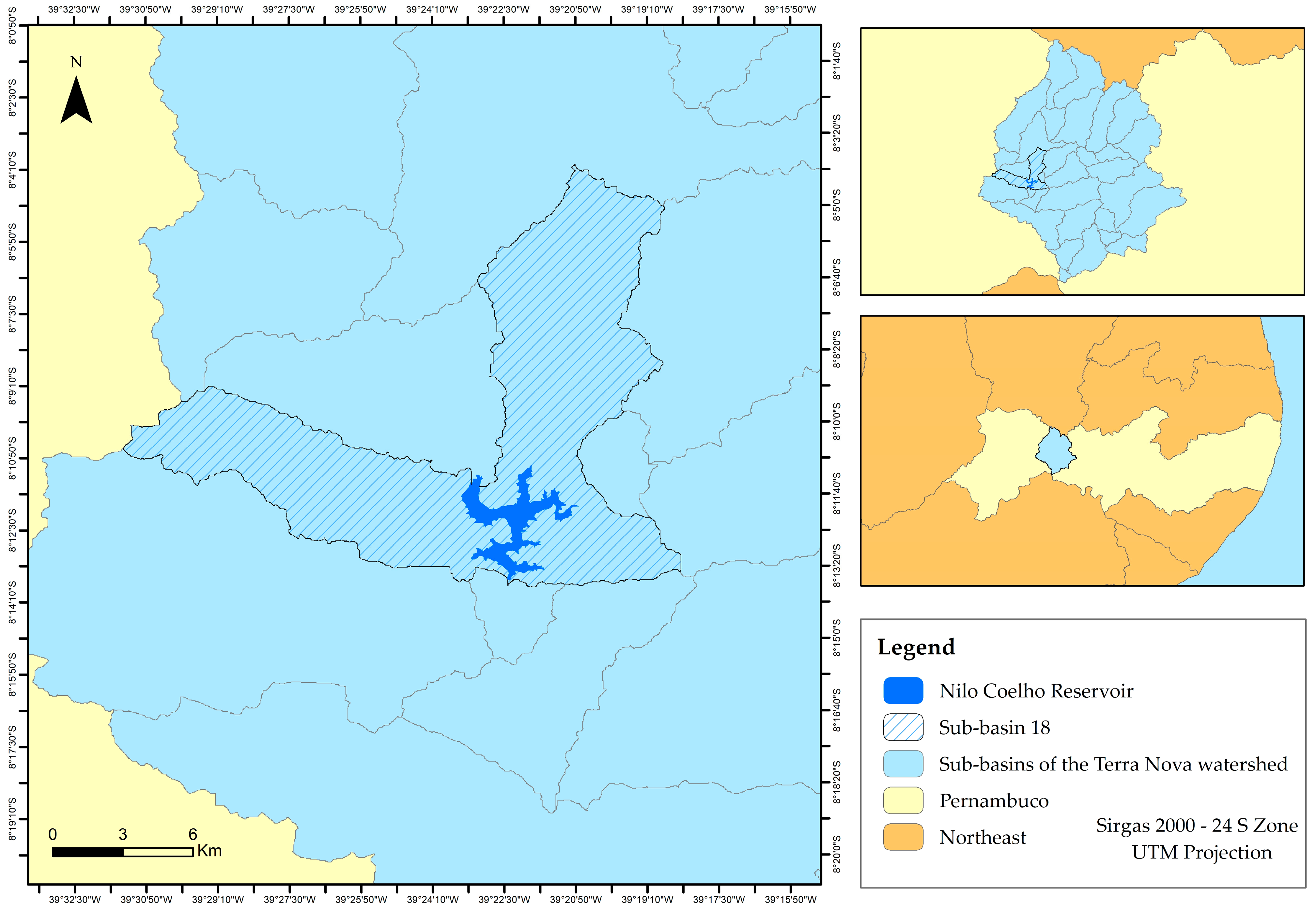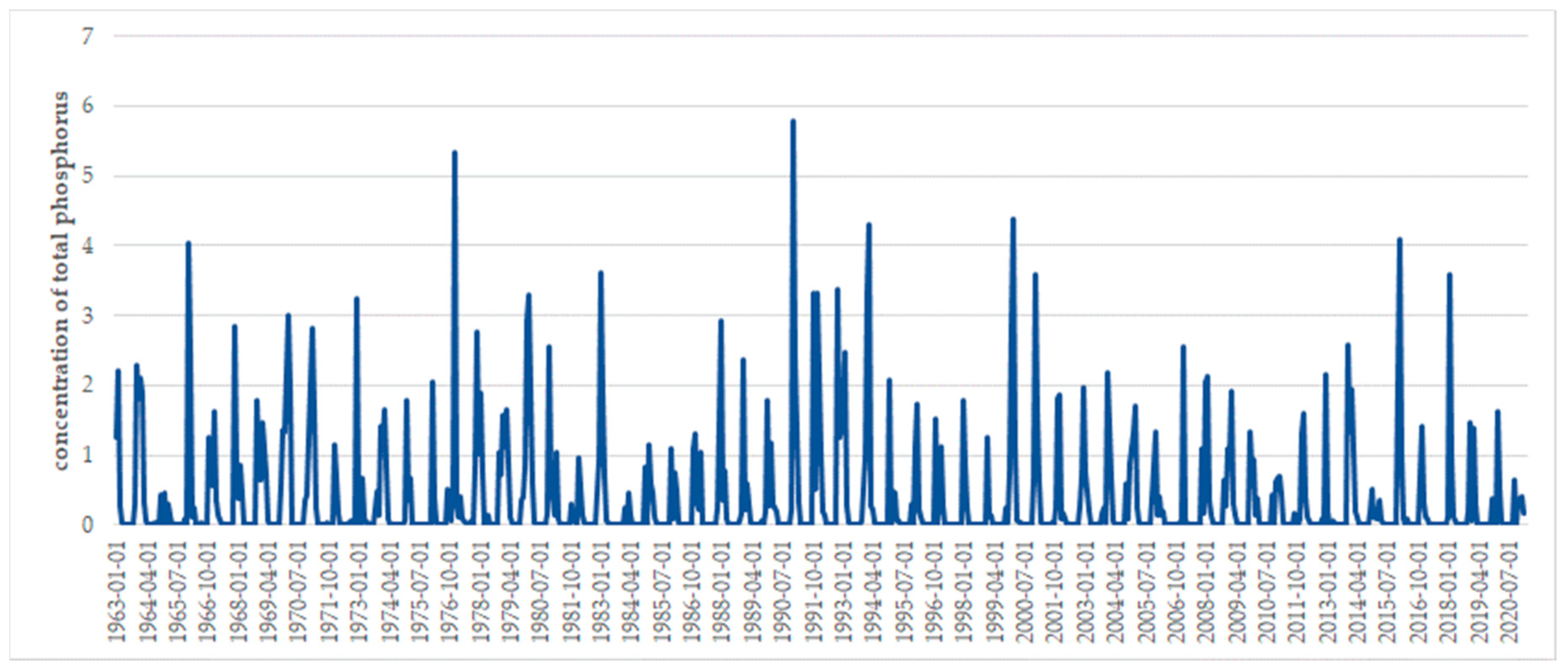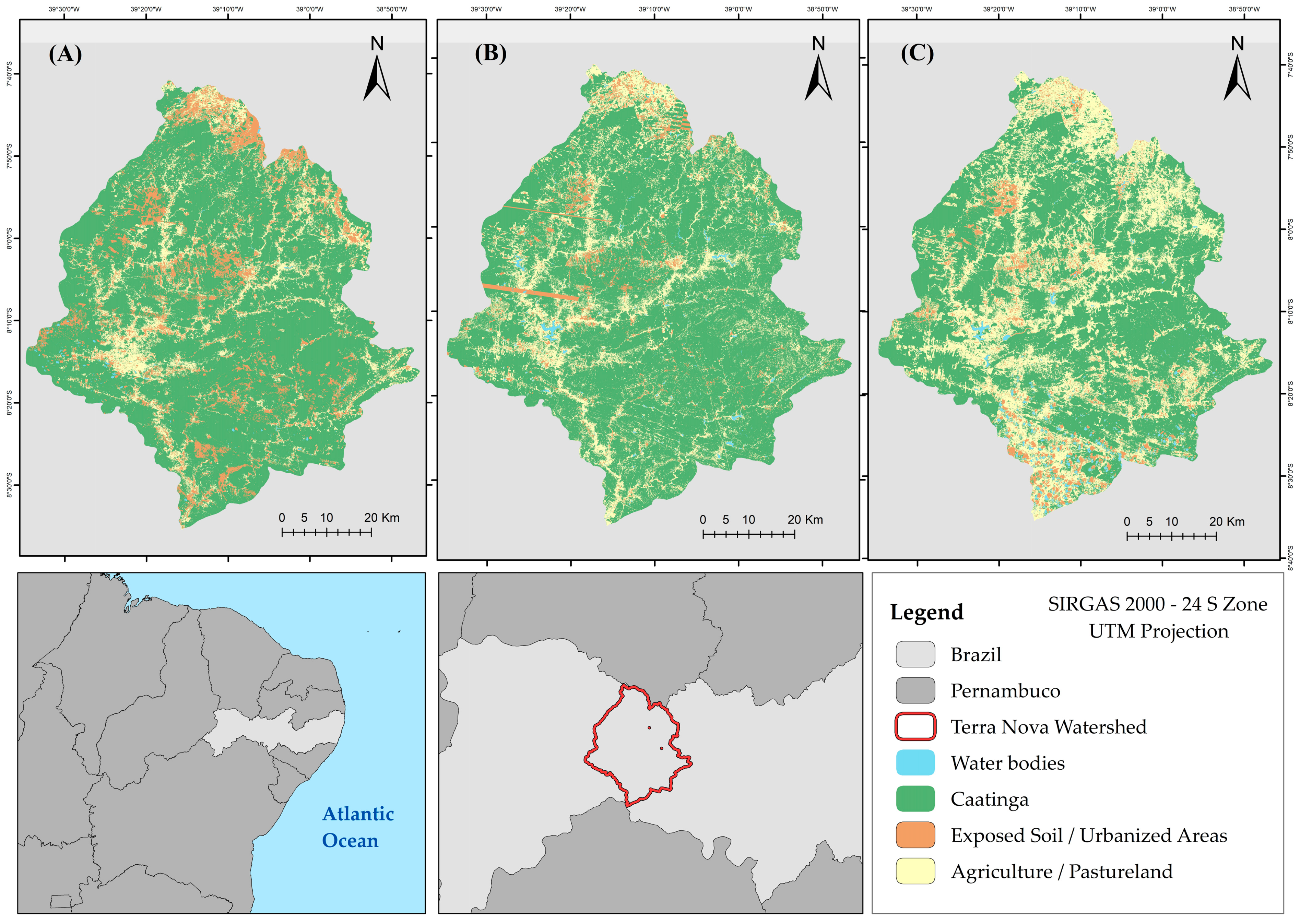1. Introduction
The impacts of the growing demand for water, in addition to its multiple uses, have caused crises of scarcity and, consequently, conflicts, threats to health, and risks to development [
1]. In regions where water availability is reduced, as is the case in the Brazilian northeast, problems related to scarcity are more frequent and associated with natural causes, such as climatic issues, accentuated by anthropic actions in watersheds [
2].
The concern with the supply of water in quantity and quality contemplates the Sustainable Development Goals (SDGs). The document created by the United Nations (UN) in 2015, called Agenda 2030 [
3], has 17 objectives and 169 goals. Among them, SDG 6—clean water and sanitation—stands out, which aims to “ensure the availability and sustainable management of water and sanitation for all”, as well as universal and equitable access to fresh water, the reduction of water pollution, and the integrated and participatory management of water resources [
3].
Anthropic interference causes changes that can affect the physical and chemical characteristics of the soil, which can initiate erosive processes, increase salinity and, consequently, alter the properties of water and the hydrological cycle in a watershed [
4]. The increase in degradation in watershed areas occurs due to the removal of natural areas and replacement by other types of land use [
5], reinforcing the need for mapping studies of land use and occupation for the planning and management of water resources, since they portray the consequences of anthropogenic activities on the natural elements [
6,
7].
The monitoring of water quality is a limiting factor in the proposition of certain activities in a region, and in Brazil, it is one of the tools for water management established by the National Water Resources Policy (PNRH) [
8], classifying water bodies according to their main uses. The National Council of the Environment (CONAMA), through Resolution No. 357 of 2005 [
9], recommends the limits of several parameters for the classification of water bodies in Brazil.
Each parameter interferes differently with water quality, among which dissolved oxygen, nitrate, and phosphorus can be highlighted as some of the most used parameters for its evaluation [
10]. Dissolved oxygen (DO) is one of the best indicators of the conservation of water bodies, as it is related to physical, chemical, and biological parameters [
11]. In surface waters, nitrate is the main form of nitrogen present and, when absorbed by plants, contributes to the growth of algae and aquatic plants [
10]. Similar to nitrate, phosphorus is a nutrient relevant to biological processes, and its excess can cause eutrophication of water bodies [
11].
The issue of water quality has emerged as a growing concern among world policymakers, which highlights the negative impact of human activities on water resources. The World Health Organization (WHO) has published guidelines for the quality of fresh water, emphasizing the importance of ensuring the safety and accessibility of the resource and evidencing the influence of human activities and forms of land use and occupation on water quality: “potentially polluting human activity in the catchment will influence water quality downstream and in aquifers” [
12] (p. 12).
In Brazil, studies have been conducted to analyze the impact of land use and occupation on water quality. The National Water Resources Policy [
8] has comprehensively addressed this concern, seeking to establish guidelines and policies to preserve and restore the quality of Brazilian waters. In this context, the Environmental Plan for the Conservation and Use of the Artificial Reservoir Environment (PACUERA) stands out, which emphasizes the study of water quality as an essential element for the characterization of the impacts of polluting anthropogenic activities on water resources [
13].
Information on water quality data is essential for managers to develop measures to protect, preserve, and improve water resources, especially in regions characterized by low water availability [
14,
15]. The state of Pernambuco is considered the smallest Brazilian state in terms of water availability per inhabitant, presenting 1320 m
3/inhabitant/year, equivalent to 3.5% of the national average [
16]. The Pernambuco Water and Climate Agency (APAC), responsible for the application of water policy in the State, has developed actions and research for better management of water resources, using technological innovations, such as environmental modeling software.
An example of an innovative tool developed is the Hydrological Response Unit System for Pernambuco (SUPer), an advanced system for modeling water quantity and quality that has considerably increased the usability of the Soil and Water Assessment Tool (SWAT) in terms of simulating the effects of management practices on different types of soil, vegetation cover uses, and scenarios of climate change in hydrology, water quality, and sediment production in Pernambuco watersheds [
17].
The absence and lack of hydrological data constitute one of the main difficulties for the development of more effective management of water resources in the northeastern region of Brazil. Given this scenario, the use of hydrological models can be an alternative for monitoring areas affected by water scarcity problems. For this reason, the present study aimed to develop a temporal analysis of water quality parameters through SUPer for the Nilo Coelho reservoir, located in the municipality of Terra Nova, a semi-arid region of the state of Pernambuco, associating it with the land uses of the watershed.
4. Discussion
Water quality is a crucial issue for achieving Sustainable Development Goal (SDG) 6, which aims to ensure the availability and sustainable management of water and sanitation for all. Among the goals of SDG 6 is target 6.3, which highlights the concern to improve water quality by reducing pollution, eliminating dumping, and minimizing the release of chemicals and hazardous materials into water resources. To monitor the evolution of water quality, the indicator proportion of water bodies with water of good and safe quality for specific uses, such as human consumption, agricultural activities, and recreation, corresponding to indicator 6.3.2, is adopted [
3].
The growing demand for water, resulting from its multiple uses, is a concern for management agencies, since the water security of regions that already suffer from water scarcity, such as in the Brazilian northeast, is related to the equal supply of water in quantity and quality [
38]. However, a major obstacle to advances in research and more effective measures to meet these demands is the absence of hydrological data in this region. Recent research [
39,
40] highlights that the scarcity of information in the northeast region of Brazil interferes with the development of studies, since there are few historical series related to water quality, in addition to incipient spatiotemporal analyses, due to the low number of monitoring stations.
Due to the deficit in the availability of water quality data observed for the Brazilian northeast, hydrological models emerge as an alternative for the management of water resources. Therefore, the applicability of SUPer as a water quality analysis tool emerges as an important instrument for water management, given its robust series of data from 1963 to 2021, assisting in the planning and proposition of public policies that guarantee the quality of water bodies [
38].
In the present study, the historical series of dissolved oxygen, nitrate, and total phosphorus were analyzed, following the resolution of CONAMA 357, for class 2 fresh waters [
9], since the state of Pernambuco does not yet have a framework of its water resources. For DO, CONAMA [
9] establishes a limit of 5 mg L
−1, the same value defined by the WHO [
12]. As for nitrate, the limit is 10 mg L
−1 and, for the WHO, the limit for this variable is 50 mg L
−1. For total phosphorus, the value of 0.03 mg L
−1 is established for lentic environments.
Regarding DO, the concentration of this parameter is usually higher in environments with low trophic levels, reaching values above 5 mg L
−1 [
41]. Mean values of RE between 7.9 mg L
−1 and 8.0 mg L
−1 and values of 5.34 mg L
−1 to 6.18 mg L
−1 were observed in the hydrographic basin of the Longá River, Piauí [
39] and in the La Vega dam, Mexico [
42], in this order. In the region of the lower São Francisco, Sergipe, values above 5 mg L
−1 were also observed, in compliance with current legislation [
43].
The degree of water deoxygenation is related to the concentration of organic matter associated with high temperatures, especially in shallow lagoons, as occurs in most Brazilian lakes and reservoirs. These ecosystems suffer large variations in water level, accentuated in the rainy season, increasing the concentration of organic matter, which directly interferes with the dynamics of dissolved oxygen [
32].
Concentrations of DO below 5 mg L
−1 were identified in the Moxotó River watershed, Brazil, in the reservoir of the Nova Ponte hydroelectric plant, Minas Gerais, and the Piemonte hydrographic basin, wherein periods of greater rainfall, there is a reduction in the DO, which may contribute to greater availability of organic matter for water from surface runoff in the drainage basin [
38,
44,
45]. Several authors point to dissolved oxygen as the most important parameter, as it is essential for the survival of aquatic organisms. Thus, in cases of low oxygen concentrations, there is a problem in the ecosystem [
32,
41,
46].
As for nitrate, its concentration in water bodies should not exceed 10 mg L
−1 [
9]. Studies carried out in the Piemonte hydrographic basin, in the Barra do Juá dam, in the Pajéu River watershed and in reservoirs on the east axis of the São Francisco Integration Project (PISF), identified small variations and low nitrate levels, within the limits established by the resolution [
43,
47,
48].
Values above 10 mg L
−1 were observed in the rainy season. The same was observed in analyses carried out in the Parnaíba River, which may be indicative of pollution [
16]. Studies indicate that eutrophication is the main problem associated with high nitrate concentrations since it is an indispensable element for algae growth [
49]. When in excess in the environment, these organisms can cause changes in water bodies, such as organoleptic problems, transparency, oxygen reduction, fish mortality, and obstruction of waterways.
In watershed areas where there are irrigated agriculture activities, increased nitrate may be associated with agricultural practices, fertilizer use, soil disturbance, erosion, and drainage [
42]. Since it is present in most surface water and comes from human, animal, and fertilizer sources, nitrate may reflect the condition of water sanitation [
50], reinforcing the need to be careful with water intended for human supply and consumption, since the presence of nitrate can cause damage to health [
41].
For total phosphorus, the limit established in lentic environments is 0.030 mg L
−1 [
9]. As in the present study, values above this limit were observed in studies carried out in the Hydrographic Basin of Escola do Jacaré (CWB) and in the Nova Ponte Hydroelectric Power Plant, Minas Gerais, which may be related to the fertilizers used in the agricultural activities of the region [
43,
44], since there is strong anthropic interference in the surroundings of the reservoir, in addition to the existence of crops. In the surroundings of the reservoir, the predominance of lithic neosols and chromic luvissols favors the leaching of sediments and fertilizers, since they are characterized by being shallow, sandy soils, with the occurrence of tonality on the surface, in addition to a strong tendency to erosion [
10].
In a study developed at the La Vega dam, Mexico, values between 0.15 and 0.59 mg L
−1 were observed, above the limits established by the Mexican standards of 0.025 mg L
−1 [
42]. Phosphorus is considered a limiting nutrient for primary aquatic producers [
45]. High concentrations of phosphorus are one of the main causes of eutrophication in the aquatic environment. They may be related to anthropic activities, due to the release of domestic sewage, industrial effluents, as well as fertilizer residues, which contribute to the increase in the concentration of nutrients in the water column, accelerating the eutrophication process [
5].
The development of activities in areas close to reservoirs can interfere with hydrological dynamics, among which domestic dumps, organic contamination, and pesticides, can cause changes in water flow, and nutrient cycles and, consequently, affect living resources and water quality [
4,
13]. The National Water Resources Policy in Brazil [
8] establishes an articulated management of water and soil, promoting policies that integrate land use, occupation, and conservation policies with water resources policies.
Thus, it is essential to develop studies on the use and occupation of land in areas close to water bodies, seeking to understand how the activities developed by man can interfere with the water dynamics of the region. The improper use of the soil can contribute to the transfer of nutrients to the reservoirs, as in intensive agricultural activities, in this way, the form in which man uses, occupies, and manages the soil directly implies the quality of the water [
13].
In the present study, the classes of water bodies, exposed soil or urbanized areas, agriculture or pastures, and caatinga were analyzed. For the class of water bodies, it is possible to observe the increase in water availability in the region, due to the PISF reservoirs. Similar results were observed in the city of Belém do São Francisco, in the years 1985 and 2010, where with the construction of the Itaparica reservoir in the 1980s, there was an increase in the percentage of water bodies from 2.4% to 3.8% [
51].
As for the caatinga areas, in the surroundings of the Cachoeira II dam [
49], this class was predominant, however, in the region of the São Paulo stream watershed, in the semiarid region of Pernambuco, there was a gradual replacement of the caatinga areas by agriculture and pasture areas between 1991 and 2010 [
52], which was also observed in this study.
The growth of exposed soil areas was also found in the municipality of Belém do São Francisco, with a growth of 3.5% of these spaces between 1985 and 2010 [
53]. In urbanized areas, it is concluded that hydrographic basins located in interior regions have low representativeness since cities are considered small/medium-sized [
54]. Studies reinforce that the increase in areas of exposed soil, associated with the reduction in native vegetation, makes the watersheds vulnerable to erosive processes, requiring adequate management of these areas. Thus, the ideal is the inexistence of this type of use, because it characterizes areas devoid of vegetation, which favors environmental degradation [
55,
56].
Studies developed in the Espírito Santo watershed indicated that pasture areas represent 36.5% of the analyzed area [
55]. In the areas of the Córrego Cantagalo watershed, pasture areas were considered predominant, occupying 71.36% of the total area [
57]. The management of these areas is also recommended as an alternative for the conservation of these environments and the reduction of their environmental impacts.
Given the analyses and results obtained, it is observed that the reduction in native vegetation and, consequently, the increase in agricultural areas, due to the greater supply of water in the region, with the construction of the PISF reservoirs. However, the suppression of native vegetation leads to problems such as biodiversity loss, changes in water quality, and soil conservation [
4]. The management must happen in a participatory way, aiming at the protection and conservation of ecosystems, while also providing the development of the region, since the guarantee of water security happens when there is water available for the supply of the population and also for the development of activities that depend directly or indirectly on the availability and quality of water.












